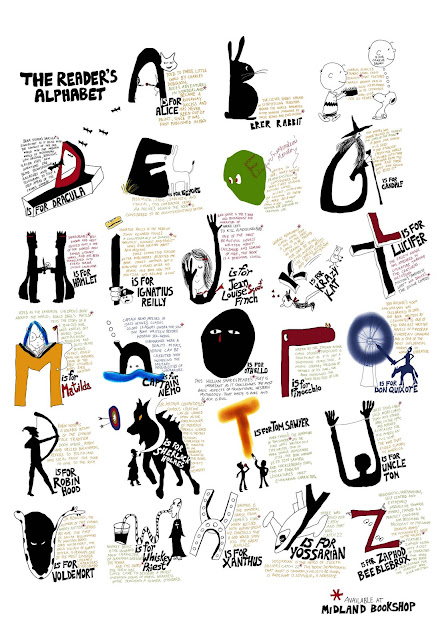Summary:(Begin thinking of a topic, we will talk more about it on Saturday)
1. Choose Topic for ABC book
2. Doodle some ideas
3. Make a list of words from A-Z, that fall within the topic.
4. Make more sketches
5. Check to make sure the text is age appropriate when
creating work for children. If you are creating an adult book,
you can be more flexible.
6. Begin finalizing sketched ideas and concepts.
7. Create handmade mock up.
8. Begin building in illustrator.
9. One 8 ½ x 11”, vertically formatted, ai. file for each page.
At first glance, coming up with a topic isn’t all that hard. The
difficulty comes in choosing just the right angle for your topic, for example writing an ABC book on food has
been done a million times, but what about foods from around the world, where
each letter could represent a food from a different country?
To start this process, I recommend looking at recent ABC books
on the market (within the past 5 years). Find out what’s selling and why. A quick check of on line retailers for popular
books can provide good ideas and trends.
When choosing a topic, look at other popular children’s books,
aside from ABC books, to get ideas as well. Discover what some of the current
themes are. One good example of this is the environment. Regardless of which
side of the political fence your views fall on concerning being green, one
thing you can’t deny is that the topic is showing up everywhere, even in
children’s books. Take advantage of such popular topics and use them as a basis
for your alphabet book. Just because you don’t see a book on a particular topic
doesn’t mean that the topic has been rejected by publishers. It could very well
mean that no one has thought to write about it yet!
In general, the more specific you
can get with your topic, the better. Instead of animals, choose a particular
category of animals, such as those that live in a certain region, or those you
might find at a zoo. Another general rule is to think globally. More and more,
publishers are trying to reach an international audience, or, at the very
least, are trying to pull their readers into a global awareness. The more you
can include other cultures and regions around the world, the more marketable
your book will be viewed by publishers.
It’s important to spend adequate time researching your potential
topic to make sure you can actually write a complete alphabet book on it. “A”
though “D” may be easy, but what about “X” through “Z”? This, of course, is the
downside of choosing a too-specific topic. But that’s where more research comes
in, and that’s what we’ll talk about next time. After all, if these books were
as easy as ABC, everyone would be writing one!
I always suggest, when starting
from a clean slate in choosing your words, to make one long list of every
possible word you can think of that deals with your topic. Let’s say you’ve
decided to do an ABC book on sea creatures. Write down every creature, big and
small, you can think of that lives in the seas and oceans. Don’t over think
your words at this point. It’s important to have as many as possible to work from.
I also recommend never leaving the house without some way of taking notes when
you’re out. You never know when that perfect word is going to pop into your
head!
After you have compiled a sizable list, organize it by
letter. Then identify those letters that have few, if any, corresponding
words. For those letters that are lacking ideas, search through both children’s
books and adult books on your topic. Check out the glossaries and indices of
those books to identify potential words. Even look at other alphabet books on
your subject for ideas.
For difficult letters, like Q or X, try to find other ABC books
by the publishers you want to submit to, to see how they treat such letters.
Some publishers are lenient and will allow authors to use words that merely have
that letter in it, as opposed to insisting that the word start with it. Other
publishers are not so lenient. You’ll need to know ahead of time what your
potential publisher prefers.
Select the link below to see common words used by grade
Once again, this is where diligent
research of both the publishers you want to pursue and their competition is
going to pay off. Some publishers will have very specific styles that any
potential ABC book must adhere to for publishing consideration. In general (I
always have to say this because there are exceptions I will surely hear about
if I don’t give this disclaimer!) you will find that the old style of “A is for
Apple, B is for Banana” is long gone.
Kids are
smart! Don’t worry about using terminology that may be a bit challenging or
concepts that might be outside their area of current discovery. Just be careful
not to go overboard with it. There’s a fine balance between challenge and
frustration. Allow children to connect their own dots as they read, and don’t
feel you have to hand over all the information to them. Let them dig a little
and use their brains!
Don’t write the
same for girls and boys. Generally
speaking, your girl reader will gravitate toward different material than your
boy reader. Girls are typically more interested in relationships,
dialogue, and emotions, where boys need to have action, intrigue, and facts.
This is not to say that you can’t write about similar topics for girls and
boys, but you should approach your story quite differently depending on your
target audience.
Publishers today are looking for a
more sophisticated approach—one that really brings the alphabet to life for a
young reader, or perhaps just helps that reader see it in a new way. One
example is to make your way through the alphabet backwards. Another is to
connect the alphabetical words in such a way that one logically leads to
another. Alphabet books can either be nonfiction
or fiction, but nowadays there needs to be some form of story involved. Gone
are the days of simply listing words in alphabetical order, even if those words
all center on a certain theme.
Contents:
1. Cover: Your name, Title of book,
artwork
2. Blank page
3. Book Text/graphic logo
4. Credit Page:Year, your name,
email address
5. Artwork (26 pages)
6. Author Bio: This can be, Who,
What, When and Why info,
or a little more. One short paragraph and your logo.
7. (May need an extra blank page
here.)
8. Back Cover: Graphic logo
Sample artwork









































